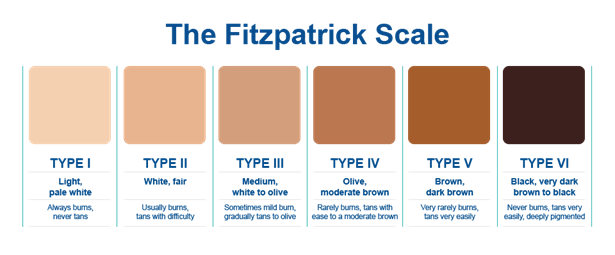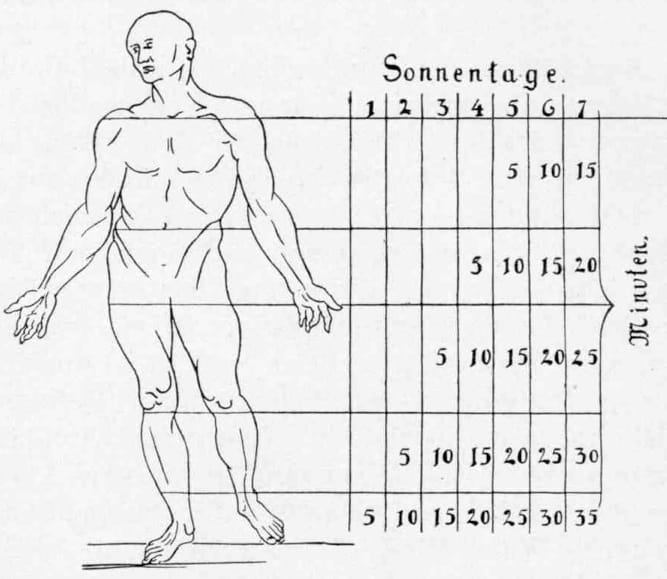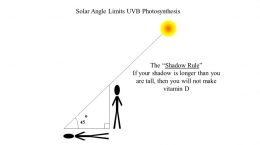Published on May 10, 2022
There are a lot of benefits derived from sun exposure, and if used correctly, sunshine can greatly improve our health. Here’s how to develop a healthy, personalized relationship with the sun!
Key Points
- Exposure to sunlight for short periods throughout the day can allow one to reap the benefits of each type of energy emitted from the sun, and although UVB rays are not always available for us to make vitamin D, there are many other health benefits from sunshine exposure that should keep us getting out into the sun besides vitamin D production
- Vitamin D is produced in the skin following direct exposure to UVB rays, which are not always available whenever the sun is shining. The presence of UVB depends on the angle of the sun to the earth, meaning to make vitamin D from the sun requires several important factors.
- Here are some important facts and tools to keep in mind to help you safely rely on sun exposure for making vitamin D while avoiding overexposure to UV radiation
 So far this Sunshine Month, we have discussed what happens within the body when it is exposed to the different wavelengths of sunshine, from the production of vitamin D, nitric oxide, melatonin, and other beneficial chemicals, to the regulation of the circadian rhythm and the microbiome on the skin, and much more. Exposure to sunlight for short periods throughout the day can allow one to reap the benefits of each type of energy emitted from the sun, and although UVB rays are not always available for us to make vitamin D, there are many other health benefits from sunshine exposure that should keep us getting out into the sun besides vitamin D production.
So far this Sunshine Month, we have discussed what happens within the body when it is exposed to the different wavelengths of sunshine, from the production of vitamin D, nitric oxide, melatonin, and other beneficial chemicals, to the regulation of the circadian rhythm and the microbiome on the skin, and much more. Exposure to sunlight for short periods throughout the day can allow one to reap the benefits of each type of energy emitted from the sun, and although UVB rays are not always available for us to make vitamin D, there are many other health benefits from sunshine exposure that should keep us getting out into the sun besides vitamin D production.
When it comes to utilizing the sun’s UVB rays to create vitamin D, it is essential to do so purposefully and mindfully. The potential harms of excessive UV exposure (the kind that results in sunburn) include the increased risk of melanoma and other forms of skin damage, so it is essential to keep in mind the number one rule of safe sun exposure: Don’t burn! Developing a personalized plan that incorporates sunshine exposure into your regular routine to maximize the benefits and make vitamin D, while being mindful not to burn, can be easily done with a few tips.
Making Vitamin D from the Sun
Vitamin D is produced in the skin following direct exposure to UVB rays, which are not always available whenever the sun is shining. The presence of UVB depends on the angle of the sun to the earth, meaning to make vitamin D from the sun requires several important factors. Watch this video for a jump-start on a few simple ways to know if you are making vitamin D from the sun.
Our bodies have the ability to produce what is called an “erythema dose” of vitamin D – a term used by doctors to define the amount of ultraviolet radiation which results in a reddening of the skin. A minimal erythema dose is defined by a pinkness of the skin about 1-6 hours after sun exposure, going away within 24 hours. There is no single erythema dose or sun exposure time recommendation, due in part to skin type and other individual differences in vitamin D production, but one minimal erythema dose is equivalent to roughly 10,000 – 25,000 IU of supplemental vitamin D, and studies show that it lasts about two times longer than oral vitamin D. And, you never have to worry about making too much vitamin D from the sun because your body self-regulates by stopping production when it has reached its limit.
Here are some important facts and tools to keep in mind to help you safely rely on sun exposure to make vitamin D while avoiding overexposure to UV radiation.
To Make Vitamin D, Keep the Following In Mind
The UV Index Needs to be Above 3
The ultraviolet (UV) Index is a measurement of the strength of the sun’s UV rays at a particular place and time. An index of 0 occurs at night when there is no UV radiation and an index of 10 corresponds approximately to mid-day summer sunlight without cloud cover (values above 10 can be found in high altitudes, near the Equator, and locations with higher ozone layer depletion).

The UV Index must be over 3 to make vitamin D, which usually occurs around midday between 10am and 2pm. UV Index varies tremendously depending on the time of day, time of year, latitude, weather, air pollution, and geographical location. You can check the UV Index on your smart phone using the weather app or you can use the free dminder app – an app that tracks sunlight and vitamin D production to maximize your body’s vitamin D generation while helping to prevent burning (see more below).
Are You Taller than Your Shadow? Height of the Sun (and Time of Day)
While you are outside in the sunshine, look at your shadow. Is it shorter than you are?

All you have to do is look at the ground to see if the length of your shadow is shorter than your height. It’s that easy! If your shadow is shorter than your height, the sun is high enough in the sky to let UVB rays shine through and reach the ground, and your skin. This is usually mid-day, between the hours of 10 am and 2 pm. Early morning and early evening, when our shadows are taller than we are, only provide us with UVA sunlight (good for making nitric oxide), not UVB which is necessary for vitamin D production.
Latitude and Season
When you can make vitamin D is also dependent on latitude and season. Those who live closer to the equator, where the midday sun is high in the sky throughout the year, have the ability to produce vitamin D year-round, whereas those north of about 34 degrees latitude (approximately Los Angeles, CA, or Atlanta, GA) experience a “vitamin D winter” for some period of time between fall and early spring when the sun never gets high enough in the sky to enable vitamin D production.
The chart above shows the typical variation of UV Index by time of day and time of year in New York City. As you can see, in New York City, the UV Index varies widely based on the season and time of day.
Clothing and Sunscreen
Greater amounts of vitamin D are made when more skin is exposed, without sunscreen or clothing, especially the back and shoulders, as these contain the most surface areas on your body. It is better to expose more skin for less time to ensure you do not overexpose yourself and burn. Ideally your skin should be exposed to the sun on a 90-degree angle. Since sunscreen blocks the UVB rays needed to produce vitamin D, it should be applied only after the exposure time allotted for making vitamin D.
Skin Type or Color
Knowing your skin type is important for personalizing your sun exposure. The Fitzpatrick scale, shown below, classifies six skin types based on the response of different skin types to UV radiation. This skin type quiz can help you determine your type.

The darker your skin, the more melanin it contains and the less likely you are to burn. Melanin acts like a natural sunscreen; the sun protection factor (SPF) of a natural tan is roughly equivalent to the actual protection of an SPF 50 sunscreen for an average user, considering most users apply only 25% of the recommended amount.
Amount of Time in the Sun – Avoid Sunburn!
The amount of time spent in the sun can be personalized according to skin type and UV Index. Once you have identified your skin type, you can use tools such as the free dminder app to approximate how much time you can spend in the sun without burning. The app helps you determine proper sun exposure based on how much skin is exposed, alerts you before you burn, and estimates your vitamin D production. You can personalize the app by entering your age, height, weight, skin type and location. Based on your location, dminder tracks the weather and current UV Index and can alert you when it is possible to make vitamin D based on that location. If you choose to link your dminder account to your GrassrootsHealth participant account, it can even track and send daily vitamin D production data directly to GrassrootsHealth!
Once you have exposed your skin (without sunscreen) for your allotted time, get out of the sun or cover up with clothing or sunscreen… it’s that easy!
How Can You Tell if You’ve had Too Much Sun?
The answer is simple – just don’t burn! Enjoying the sun safely while taking care not to burn can help to provide the benefits of sunshine without unduly raising the risk of skin cancer. Keeping track of your time in the sun before covering up can be one of the most helpful tools to prevent sunburn when enjoying the sunshine for extended periods.
Acclimating to the Sun to Prepare for Summer
Whether or not you choose to use an app, it is important to allow skin to gradually acclimate to the sun, especially for those who spend a lot of time indoors, have lighter skin, after winter months, or during sun-seeking vacations. However, it is safer to increase exposure time gradually as this allows your skin to adapt to the sun’s intensity. As the season gets warmer and sunnier, exposed skin will adapt to produce a tan.
In his lecture, Why the Sun is Necessary for Optimal Health, Dr. Alexander Wunsch presents the chart below as an illustration of how light therapists gradually acclimate the body to light (from sun or lamp).

For the first exposure session, the therapist would only expose the feet to 5 minutes of light. Session 2, after 5 minutes of exposure only on the feet, a blanket is raised to expose the lower leg along with the feet for an additional 5 minutes, etc. You can see that this is a very gradual process, the timing of which will likely vary from one individual to the next.
Other Factors that Affect Vitamin D Production
Also keep in mind that the quality of sun exposure is important for vitamin D synthesis. Cloud coverage, air pollution, sunscreen, and shade cast off from buildings all disrupt the direct contact of sunlight on our skin. Also, as a person ages, the amount of the precursor substance needed to make vitamin D decreases, lowering their skin’s ability to produce it.
Here are a few myths about vitamin D and sunshine:
- The skin cannot produce vitamin D from sunlight shining through a window – so do not assume you are getting your D while driving in your car with the AC on and windows up. The windows block the UVB from sunlight.
- You cannot wash vitamin D produced in the skin off! So, no worries if you take a shower after spending some time at the beach – you’ll do a good job of washing the sand off, but that vitamin D (which was produced in the deeper layers of the skin) will remain.
- Don’t expect to make vitamin D while also slathering on the sunscreen. Sunscreen blocks the UVB rays that produce vitamin D.
- Don’t expect to make enough vitamin D exposing just the arms and legs for 5-10 minutes a day. It likely is not enough for almost anyone!
Because of the individual variability in the above factors and the amount of UVB available from sunshine at any given moment and any given location, how much vitamin D we can make is also extremely variable. This makes measuring the vitamin D level an essential step to incorporating healthy sunshine exposure into your daily routine.
Are You Getting Enough Vitamin D from Sunshine?
 Having and maintaining healthy vitamin D levels and other nutrient levels can help improve your health now and for your future. Choose which additional nutrients to measure, such as your omega-3s and essential minerals including magnesium and zinc, by creating your custom home test kit today. Take steps to improve the status of each of these measurements to benefit your overall health. With measurement you can then determine how much is needed and steps to achieve your goals. You can also track your own intakes, symptoms and results to see what works best for YOU.
Having and maintaining healthy vitamin D levels and other nutrient levels can help improve your health now and for your future. Choose which additional nutrients to measure, such as your omega-3s and essential minerals including magnesium and zinc, by creating your custom home test kit today. Take steps to improve the status of each of these measurements to benefit your overall health. With measurement you can then determine how much is needed and steps to achieve your goals. You can also track your own intakes, symptoms and results to see what works best for YOU.
Enroll in D*action and Test Your Levels Today!






